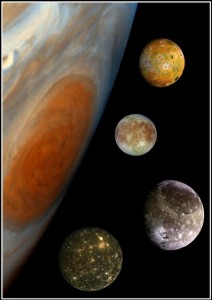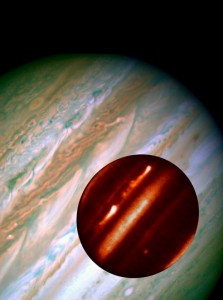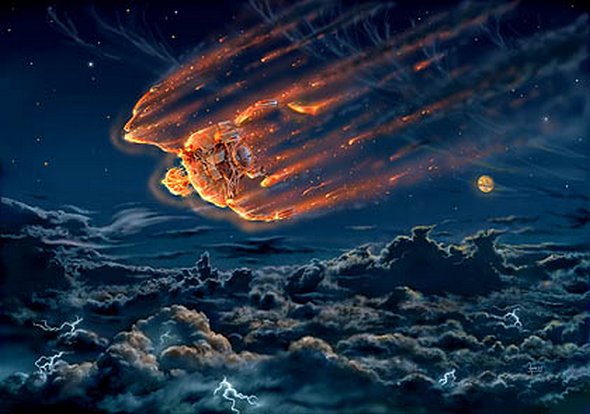 Planetary scientists detected that an anticyclone on Jupiter called the Little Red Spot produces winds up to 384 miles per hour, far exceeding the 156 mph mark that would make it a category five storm on Earth. Scientists measured wind speeds and directions by tracking the motion of cloud features from two image mosaics from a telescopic Long Range Reconnaissance Imager, taken 30 minutes apart. They combined the LORRI maps with visible-color images from Hubble, and mid-infrared images from the European Southern Observatory’s Very Large Telescope allowing scientists to “see” thermal structure and dynamics beneath the visible cloud layers.Jupiter’s Great Spot isn’t as great as it used to be. It’s actually been steadily shrinking for decades. Now, its younger, smaller sibling, the Little Red Spot, may be taking over the spotlight.The planet Jupiter looms out in space. Its famous feature, the Great Red Spot ” a massive, swirling storm ” can be seen from your backyard. “If you look at Jupiter through a telescope, it is the red spot you can see,” said Andrew Cheng, a planetary scientist at the Johns Hopkins Applied Physics Laboratory. Now, a newer, younger storm called the Little Red Spot is growing despite its name and proving to be fierce competition for the top spot on Jupiter. “Jupiter’s red spot is a not so little, giant storm,” Dr. Cheng said. “It’s like a hurricane except that its winds blow in the opposite direction”.
Planetary scientists detected that an anticyclone on Jupiter called the Little Red Spot produces winds up to 384 miles per hour, far exceeding the 156 mph mark that would make it a category five storm on Earth. Scientists measured wind speeds and directions by tracking the motion of cloud features from two image mosaics from a telescopic Long Range Reconnaissance Imager, taken 30 minutes apart. They combined the LORRI maps with visible-color images from Hubble, and mid-infrared images from the European Southern Observatory’s Very Large Telescope allowing scientists to “see” thermal structure and dynamics beneath the visible cloud layers.Jupiter’s Great Spot isn’t as great as it used to be. It’s actually been steadily shrinking for decades. Now, its younger, smaller sibling, the Little Red Spot, may be taking over the spotlight.The planet Jupiter looms out in space. Its famous feature, the Great Red Spot ” a massive, swirling storm ” can be seen from your backyard. “If you look at Jupiter through a telescope, it is the red spot you can see,” said Andrew Cheng, a planetary scientist at the Johns Hopkins Applied Physics Laboratory. Now, a newer, younger storm called the Little Red Spot is growing despite its name and proving to be fierce competition for the top spot on Jupiter. “Jupiter’s red spot is a not so little, giant storm,” Dr. Cheng said. “It’s like a hurricane except that its winds blow in the opposite direction”.

 The counter-clockwise winds make the storm an anticyclone, and for the first time, planetary scientists have recorded wind speeds of up to 385 mph, the highest ever detected on a planet. That’s 185 mph faster than any category 5 hurricane on earth. “It’s much bigger than any hurricanes that are found on earth”, Dr. Cheng said. “It’s bigger than earth itself”. The Little Red Spot started out white and recently turned red. Researchers believe increased wind speeds stirred up material that was exposed to ultraviolet radiation, causing a chemical change to make it look red. “Many features in Jupiter’s atmosphere change color from time to time”, Dr. Cheng said. “Now, it looks very much like the Great Red Spot. It’s just a smaller version of it”.
The counter-clockwise winds make the storm an anticyclone, and for the first time, planetary scientists have recorded wind speeds of up to 385 mph, the highest ever detected on a planet. That’s 185 mph faster than any category 5 hurricane on earth. “It’s much bigger than any hurricanes that are found on earth”, Dr. Cheng said. “It’s bigger than earth itself”. The Little Red Spot started out white and recently turned red. Researchers believe increased wind speeds stirred up material that was exposed to ultraviolet radiation, causing a chemical change to make it look red. “Many features in Jupiter’s atmosphere change color from time to time”, Dr. Cheng said. “Now, it looks very much like the Great Red Spot. It’s just a smaller version of it”.
By keeping an eye on all of Jupiter’s spots, scientists hope to get a better understanding of weather on other planet, too.
ABOUT THE LITTLE RED SPOT: The Little Red Spot on Jupiter is an anti-cyclonic storm formed by the merger of three separate storms observed since the 1930s. In 1998 two of the storms came together and were joined in 2000 by a third to form a storm roughly the size of the planet Earth. Using data from recent telescope and spacecraft observations, scientists determined that the storm has some of the highest wind speeds ever detected on any planet. In 2005 it started turning red for unknown reasons, and now it looks similar to its larger, more famous neighbor, the Great Red Spot. The peak wind speed for the Little Red Spot is in excess of 384 miles per hour.
WHAT IS AN ANTI-CYCLONE? Unlike hurricanes, which rotate around a center of low pressure, anti-cyclones rotate around centers of high pressure. On earth that means that air at lower elevations is forced away from the center, creating an opening that pulls cold air down from above. That leads to low humidity and few clouds. On Earth, anticyclones are often predictors of fair weather, though special conditions can create anti-cyclonic tornadoes. There are examples of anti-cyclonic storms on other planets, such as Jupiter, Saturn, and Neptune.





















Connect yourself with Chill Out Point to get daily updates!
SUBSCRIBE to Chill Out Point's News Feed to receive our fun articles as soon as we publish them. Don't forget to join our online communities on FACEBOOK and TWITTER.Newest fun stories available on Chill Out Point's news feed !